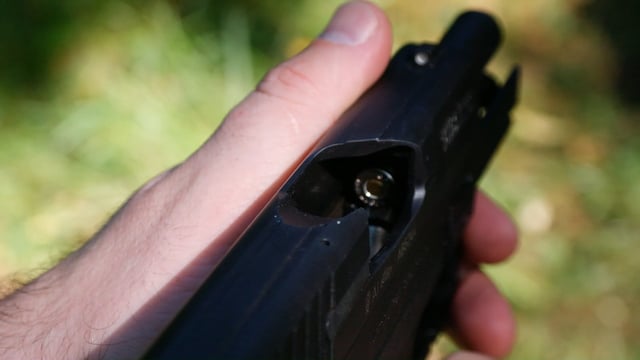Firearm carry conditions are primarily a way to declare the readiness of the weapon. For instance, if you’re on the firing line and the range safety officer calls out “cease fire, cease fire, unload, show, clear — weapons at Condition 4” — it’s helpful to actually know what that means.
In this case, Condition 4 is pretty much the universal “safe”. There is no round in the chamber (because you visually inspected) and the magazine is out of the firearm. With these two stipulations, the firearm can quickly be inspected by a range safety officer or other suitable person to be determined if it is clear and safe for handling.
Whenever you’re passing a firearm off to someone else, it’s always a great idea to put that firearm in Condition 4. That person should always then inspect the firearm to ensure it is clear. This really cuts down on any chance of a negligent discharge.
Table of Contents
In this article, we’ll discuss the 5 carry conditions ratings commonly associated with Single-Action/Double-Action and striker-fire pistols. Not all pistols will need to pass through each condition. In fact, when I was in the Marine Corps, there were commonly only 4 conditions associated with most of our weapon systems. It seems there’s an added “Condition 0” included nowadays — which just goes to show I’m getting old.

THE 5 CARRY CONDITIONS
*Condition 0 — Magazine inserted, round in the chamber, safety off.
- For SA/DA — Hammer is back.
Condition 1 — Magazine inserted, round in the chamber, safety on.
- For SA/DA — Hammer is back.
Condition 2 — Applies to Single-Action/Double-Action primarily. This is a magazine inserted, round in the chamber, hammer forward. For revolvers, it would be rounds inserted into cylinder, cylinder locked into place, hammer forward.
Condition 3 — Magazine inserted, no round in the chamber.
- For SA/DA — Hammer is forward.
Condition 4 — No magazine inserted, no round in the chamber.
- For SA/DA — Hammer is forward.
- For SA/DA revolvers — Hammer is forward, cylinder is clear of all rounds.
EXAMPLES OF CARRY CONDITIONS
Condition 4 is considered safe for transport in a range environment. Some ranges have looser restrictions than others but all across the board – Condition 4 is always a good idea until you are given permission by the range safety officer (or ordinances governing the range) to proceed from Condition 4 to 1/0.
So, as you can see, Condition 0 and 1 are separated only by a manual safety. The firearm is loaded, hammer to the rear, and a round is in the chamber. This firearm should be handled with caution and treated with respect (at ALL conditions – but especially these two).
While condition readiness truly applies to little outside the range environment, it is something that we consider in our situational awareness. For instance, many concealed carriers carry in Condition 3. That’s because they don’t want to have a round in the chamber. This is one of the carry conditions that isn’t recommended, as your firearm isn’t truly ready for the fight.
For those who carry 1911 variants or SA/DA pistols, Condition 2 is extremely common.
For striker-fire (Glock 19, etc.) carriers who feel confident in their carry abilities, Condition 0 is common.
CONCLUSION
It comes down to familiarity with the firearm, competency with its mechanics, and confidence that you can use it without doing harm to yourself or others unintentionally.
Condition readiness is a great way to communicate to other firearm operators where you’re at and where they need to be. More importantly, it’s a great way of communicating safety.
So, next time you hear a range safety officer say, “go to Condition 1”, you know to make ready and be prepared to have a great day at the range. Know the conditions not only for the range, but know condition carry as well. You should always be aware of what condition your firearm is in.











![[FIREARM REVIEW] Canik TP9 SFx Full Size Competition Pistol](https://imagedelivery.net/sbm_lYeJbALkepJgtmRD5w/concealednation.org/2017/03/ScreenHunter_675-Mar.-14-20.39.jpg/w=728,h=381)


